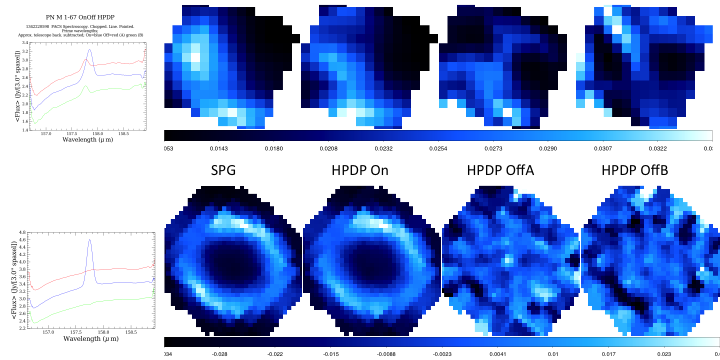PACS On/Off Spectra - Herschel
SEPARATE ON-SOURCE and OFF-SOURCE PACS-S SPECTRAL CUBES

Examples of separate on-source and off-source cubes compared to the standard (SPG) cubes
INTRODUCTION
Most PACS spectroscopy SPG products -- the standard products provided via the HSA -- are background subtracted. If one wished to compare the on-source to the off-source (background) data separately, it would be necessary to re-process the data in HIPE. This processing has been done by experts at the HSC and the resulting separate on-source and off-source cubes are provided as this HPDP. For details of how these cubes were created and how they can be used, please read the Release Note.
These HPDP can be obtained from the HSA only (they were too large to provide as a single tarball elsewhere). For each observation, the scripts that were used to create these HPDPs are provided on a local respository (specifically this tarball). These can be used to create alternative versions of the HPDP cubes, following the advice in the Release Note.
For those who wish to know how to deal with PACS spectoscopy data where emission over that from the telescope itself (and in particular, any emission lines) is found in the off-source data, read the Release Note, and the Technical Note which is linked from there. It is very important to note that off-source emission, whether or not it is expected, may need to be dealt with in a different way to non-"contaminated" data.
SCOPE AND CONTENT OF THE DELIVERY
The purpose of these HPDPs is that users can easily load the cubes into any cube-viewing software and inspect them, in particular to compare the spectra off-source to those on-source. If emission is found in the off-source position, it may be necessary for the user to reprocess the observation in HIPE, although it is also possible that the HPDP cubes or the SPG cubes can be used. The various scenarios are explained in the Release Note and Technical Note.
For each observation, for each camera and each wavelength slice in the observation, one "equidistant mosaic cube" of the on-source pointing, and one (for unchopped observing mode data) or two (for chop-nod observing mode data) cubes of the off-source pointings, is provided. The type of mosaic cube (projected or interpolated) depends on the pointing mode of the observation.
The cubes should load into any cube-viewing software; the spectral and spatial dimensions are fully defined. The FITS file sizes range from a few to about 20 MB.
- Removed a total of (3) style text-align:center;








































 Sign in
Sign in
 Science & Technology
Science & Technology